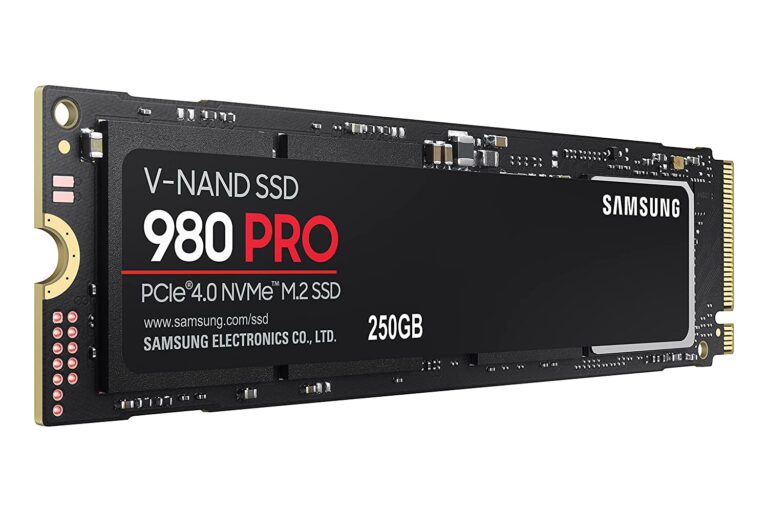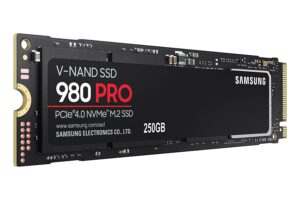NVMe drives have gone from being a one-off a few years ago to being the standard for system manufacturers. They’re simple to install, have far greater performance than SATA SSDs, and can be very inexpensive. Samsung has some great PCIe 3.0 NVMe controllers, so the announcement of the new 980 Pro series sparked some interest. This drive is a vast cry from Samsung’s prior flagship NVMe drive designs, as well as the Phison E16 controller, based solely on specifications.
However, for those who desire far more performance, a younger breed of upgraded NVMe drives has arrived that can make use of PCI Express 4.0’s greater bandwidth.
The first generation of PCIe 4.0 drives hampers by the fact that Phison only offered one controller, the E16. Because the first controller approach had several flaws, system builders were eager to evaluate more options.
There is more to this tale than PCIe 4.0’s higher bandwidth? Yes, in a nutshell.
What you will see here?
Design & Structure

For anyone with design ambitions, NVMe drives aren’t an open goal. Small single-sided cards containing surface-mounted circuitry and, if we’re lucky, a label.
Almost every other PCIe 4.0 NVMe disk seen has a heatsink of some kind to prevent heat build-up during extended use.
Samsung doesn’t think this is a problem with the 980 Pro because it doesn’t come with a heatsink or any obvious modifications to keep it cool while in use. Fortunately, many motherboard manufacturers are more concerned about heat, and most, at least on gaming boards, offer at least 1 M.2 slot with an inbuilt cooling.
The drive seems to be the standard 2280 length and will fit and work in an existing PCIe 3.0 M.2 slot. If you aren’t ready to build a new system but need storage right away. However, in PCIe 3.0 mode, it will only supply around half the performance of PCIe 4.0 mode.
Specs & Features
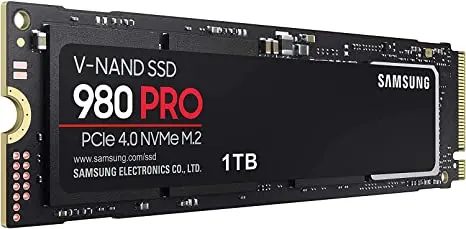
These specifications of the various capacity variants of the 980 Pro require some investigation, as the skills of the 250GB & 500GB versions differ from those of the 1TB version, and based on those numbers, the 2TB is the best performance when it finally arrives.
The variances are due to the amount of NAND modules used by each. As parallel transfer processes boost the overall speed.
Looking at the 980 Pro’s specifications indicates that the internal hardware configuration varies dramatically depending on the capacity, and these differences can have a substantial impact on performance. You’re not merely picking the right size.
The LPDDR4 DRAM is the quickest memory here on 980 Pro, followed by the SLC cache. But then the drive’s active storage, TLC NAND. The 1TB model comes with 1GB of DRAM, while the two smaller sizes get half that. The 1TB drive also includes between 6GB & 114GB of SLC cache, compared to 4GB to 49GB for the 250GB drive and 4GB to 96GB for the 500GB disc.
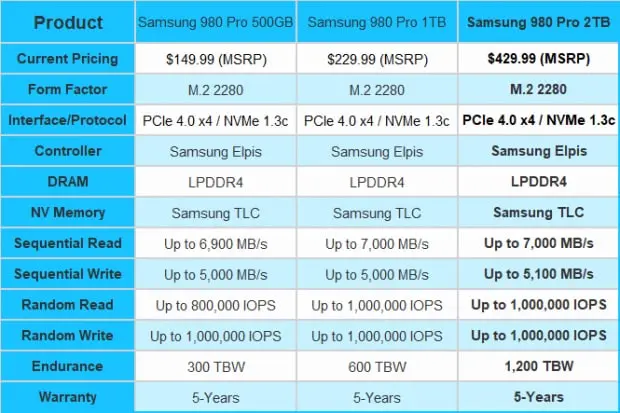
The SLC cache here on a larger 1TB drive, on the other hand, is wired differently. The 250GB drive’s write performance peaks at 2,700MB/s, while the 500GB & 1TB drives could handle 5,000MB/s.
Samsung 980 Pro: Influence on the TLC
Finally, the increased parallelism here on larger drives has an influence on the TLC, reducing its without cache performance of a 250GB unit to 500MB/s, the 500GB version to 1,000MB/s. As well as the 1TB version to 2,000MB/s.
These are the rates that will appear when the cache & DRAM are both saturated. They aren’t all that dissimilar from what we may see on PCIe 3.0 NVMe devices that employ similar NAND modules.
It’s a wonder Samsung bothered with 250GB & 500GB sizes, given the lower TBW that smaller drives offer as an extra reason against the smaller drives. There appears to be no clear justification for them to exist based only on specs.
PCIe 3.0 vs. PCIe 4.0
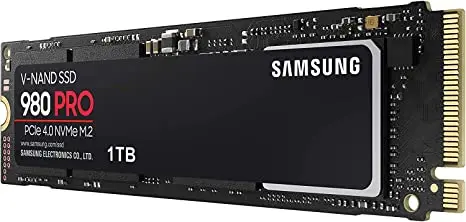
We need to speak about what PCI Express (PCIe) 4.0 offers above and above the conventional PCIe 3.0 that most computers utilize because it is a fairly new concept.
PCIe has gone through a number of modifications since it superseded PCI/PCI-X & APG slots in 2003, starting with version 1.0a and continuing via 1.1, 2.0, 2.1, 3.0, 3.1, and currently 4.0.
Version 5.0 already is documented, version 6.0 is in the works, and development will definitely continue.
Whereas early computer technology concentrated on parallel connections, including the old ribbon wires in IDE drives, PCI, and USB are based on high-speed serial communication. As well as the speed of such serial data streams has grown with each generation.
PCIe 3.0 seems to have a data throughput of 0.985 GB/s per PCIe lane, & PCIe 4.0 doubles that to 1.969 GB/s per PCIe lane. So when technology finalizes, versions 5.0 and 6.0 predict to double and treble those numbers.
Samsung 980 Pro: M.2 port
Each M.2 port on even a PCIe 3.0 motherboard contains two or four PCIe lanes assigned to it, with four being the most common. This results in a potential throughput of 3.938GB/s. This bandwidth effectively limits any NVMe linked by one of the other ports too far less than 4GB/s of reading or writing, with the best delivering around 3.8GB/s.
On a four-lane M.2 slot, PCIe 4.0 theoretical bandwidth jumps to 7.877GB/s, boosting data flow to and from that device to the over 7GB/s, assuming it is configured to fully utilize PCIe 4.0 mode.
The same performance could be accomplished with PCIe 3.0 by designating 8 lanes to the slot, or a carrier card could do this twice in a PCIe x16 slot. Since most enthusiast motherboards & processor combinations don’t have enough PCIe lanes to employ eight lanes on each M.2 slot, it wasn’t a consumer choice.
What will PCIe 4.0 mean for video cards is an apparent question that a few of you may have?
What will PCIe 4.0 mean for video cards is an apparent question that a few of you may have? The truth is has almost little effect on video card speeds, which is counterintuitive. All performance-related work, aside from loading geometry & textures onto the car. It takes place between both the card memory as well as the GPU and is thus unaffected by PCIe throughput.
It’s a well-known truth that attaching current video cards to PCIe 3.0 x8 slots rather than x16 lane slots doesn’t significantly slow them down.
For whatever reason, AMD computers are the only way to get PCIe 4.0 right now. When PCIe 4.0 has become a standard in 2017, Intel’s CPU and motherboard divisions appear to have missed that crucial memo.
Surprisingly, Intel seems to have a flash memory division that produces the D7-P5500 & D7-P5600 PCIe 4.0 Enterprise-class SSDs, which are only compatible with AMD systems.
B550 or X570
A B550 or X570 chipset motherboard need, as well as a Ryzen processor that enables PCIe 4.0. They built a system around the X570 chipset. Particularly PCIe 4.0 devices, as the 980 Pro would otherwise default to PCIe 3.0 speeds.
Gigabyte accidentally revealed that existing Z490 motherboards may support a single M.2 PCIe 4.0 slot using new 11th-gen processors. While Intel promised a new Rocket Lake chipset motherboard featuring PCIe 4.0 in early 2021.
These plans aren’t set in stone once new hardware is released, and could another 6 months or more until Intel has this ability to give.
Performance
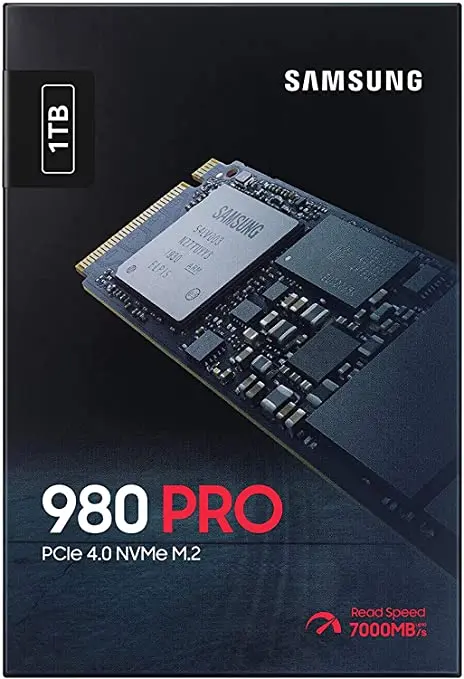
This drive supposes quick, and it is. But also wanted to learn more about some of the other concerns that PCIe 4.0 NVMe drives have, such as power consumption & heat generation.
But first, its headline numbers are astounding, with CrystalDiskMark 7.0b’s default profile yielding incredible 6,773MB/s reads & 4,917MB/s writes. Other synthetic benchmarks are far less impressive. Although they consistently outperformed the finest PCIe 3.0 NVMe products including Phison E16-based PCIe 4.0 drives.
There are, however, a few issues to be aware of. The first is a problem that certain NVMe drives based on NAND technology face when their cache is exhausted and they must default to a speed that the onboard TLC modules can support.
This would reduce write performance on the 500GB disc to around 1,000MB/s. Once the cache is saturated for the remainder of the write. Writing large files is required to observe this issue. But if you toss something large enough at any NAND drive, it will happen eventually.
1 TB version
If you write large files on a frequent basis, the 1TB version of this drive provides double the raw TLC performance.
The other concern is overheating, which is almost unavoidable. If you don’t have a setup with a heat spreader so over 980 Pro.
They kept the spreader off of the MSI X570 Gaming Plus when initially tried it. Because it wanted to take shots with it on the board, as well as the results were not good. The Samsung 980 Pro rate 70C, however, throttling occurred before that point, and write performance plummeted once it was reached.
This may not be noticeable to typical users who do not perform 10 benchmarks in a row. Those who want to take this technology seriously will need to use a heat spreader and possibly some active cooling all-around the slot.
Samsung’s decision to not include a heatsink is puzzling, given that every other PCI 4.0 NVMe architecture seen includes.
Is Samsung 980 Pro a good investment?

At launch, it Samsung 980 Pro is only available in three capacities: 250GB, 500GB, and 1TB. A 2TB model is mentioned on the technical specification sheet, however, it isn’t available yet.
These are one of the most costly NVMe disks per GB available in the UK, with MSRPs of £82.99, £135.99, and £207.99, respectively. It’s not available directly from Samsung, but it’s available on
The price at US$89.99, $149.99, and $229.99 on Newegg &
While it appears costly in contrast to PCIe 3.0 NVMe SSDs, the Samsung costs are similar to those of Gigabyte and Sabrent, which are both about $200 for a 1TB capacity.
Because NAND spot pricing is expected to fall owing to overstock in the coming months. It is fascinating to watch how long the 980 Pro remains this expensive.
To see what additional options you have, check out this chart of the best SSDs.
Conclusion
There are many excellent aspects to a Samsung 980 Pro. However much of it comes under the ‘be cautious what you wish for category.
On paper, increasing the bandwidth of M.2 NVMe storage systems appeared to be a no-brainer. However, that assumption overlooked the fact that this throughput’s power consumption will have a large thermal impact. But that NAND technology isn’t twice as fast this year as it was in 2019.
Assume you run programs and write data on a regular basis. In that instance, the Samsung 980 Pro will function excellently. But if you continuously push it hard, the temperature will grow. It will eventually throttle without active cooling. In thermodynamics, there is no such thing as a free lunch; with continued use, temperatures rise, and throughput speeds eventually fall below those of a PCIe 3.0 drive.
And, while the Samsung 12-Layer V-NAND 3-bit MLC on this drive appears to be fast. Since it has 1GB of LPDRR4 caching it, after it and the SLC saturate. One sees the underlying performance of a Samsung 12-Layer V-NAND 3-bit MLC, which is significantly less.
PCLe 4.0’s
Having said that, Samsung did build a controller with this device that can use the majority of PCIe 4.0’s bandwidth. Whereas many early PCIe 4.0 NVMe designs used the Phison E16 controller, which can only read at 5,000MB/s and write at 4,800MB/s.
Phison, on the other hand, has worked on the E16 and built the E18. A new controller that could eventually replace the Samsung Elpis, and there is in the Sabrent Rocket 4 Plus. Hopefully have a look at one of those shortly to see how it stacks up.
Performance improvement
There are times when the Samsung 980 Pro provides exactly the performance improvement that users desire. But this isn’t always the case.
It’s up to you to determine if a Samsung 970 Evo 500GB and similar is worth the extra 80% above the Samsung 970 Evo 500GB or equivalent for those fleeting highs. Price is a big factor here. But who in its right mind will buy a Samsung 980 Pro 1TB drive. When they could obtain a 2TB PCIe 3.0 SSD for the same money?
The Samsung 980 Pro is unquestionably the PCIe 4.0 NVMe drive to beat right now. But that doesn’t mean that should all rush out and get one, along with a system to use it with. If you do, you should stay away from the lower capacity.


